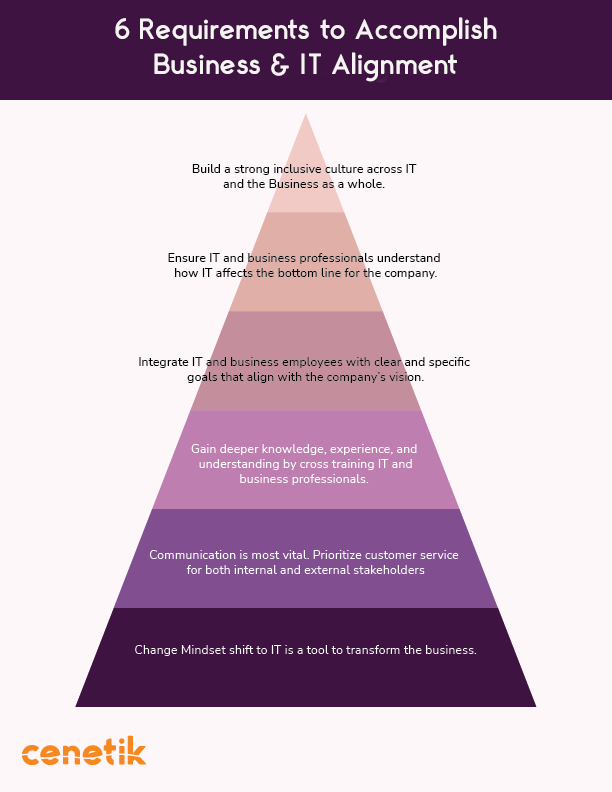
Business and IT alignment is essential for any organization to be successful. It requires collaboration between business and IT teams to ensure that the goals of both are met. In this article, we’ll discuss the 6 requirements for organizations to accomplish business and IT alignment. These requirements include: IT is a tool to transform the business, communication, cross training, integration, affects to the bottom line, and inclusive IT culture. By following these guidelines, organizations can ensure that their business and IT teams are working together towards a common goal. Here is a breakdown of the 6 requirements:
- IT is a Tool
IT is a powerful tool that businesses can use to transform their operations and gain a competitive advantage. With the help of IT, businesses can automate processes, improve customer experience, and increase efficiency. It also enables them to access real-time data, which helps them make better decisions.
IT has become an essential part of modern business operations and it is becoming increasingly important for companies to embrace it if they want to remain competitive in today’s market. By leveraging the latest technologies available, businesses can streamline their processes and maximize their profits while providing better services to their customers.
- Prioritize IT Communication with Internal and External Stakeholders
IT communication is essential for any organization in order to ensure that the internal and external stakeholders are informed and up-to-date about the latest developments. Effective communication with stakeholders is key to ensure that everyone is on the same page, helping to avoid potential conflicts. It is important for IT departments to prioritize their communications with internal and external stakeholders in order to maintain a productive working relationship. This includes providing timely updates, responding promptly to inquiries, and engaging in open dialogue about changes or challenges that may arise. By prioritizing IT communication with internal and external stakeholders, organizations can ensure they are always prepared for any situation that may arise.
- Cross Training IT and Business Professionals
Cross training IT and business professionals can help bridge the gap between the two departments and ensure that each team is aware of the other’s needs and goals. By having both sides understand each other’s work, it will create a more efficient workflow and provide better results for companies.
Cross training IT and business professionals can help improve communication between the two teams, which can lead to better collaboration. This will ultimately result in a more streamlined process with fewer mistakes. Additionally, cross training IT and business professionals can also increase employee morale by giving them an opportunity to learn new skills that will benefit their career growth.
- Integrate IT and Business Employees with Clear Goals
In order to achieve success in today’s competitive business environment, it is essential for IT and business employees to be integrated with clear goals. By working together, both departments can leverage their respective strengths and resources to create a more effective and efficient work environment. By setting clear objectives, both sides can collaborate to develop strategies that will help the company reach its goals. This integration will also allow for better communication between departments, which can lead to improved customer service and increased productivity. With a unified vision and shared goals, IT and business employees can work together to create an organization that is capable of meeting its objectives.
- Business Professionals Understand How IT Affect the Bottom Line
Business professionals understand that the use of Information Technology (IT) can have a significant impact on their bottom line. IT can help businesses to gain competitive advantage, reduce costs, increase efficiency and productivity, and improve customer service. By leveraging technology, businesses can save time and money while improving the quality of their products and services. With IT, businesses are able to automate processes, streamline operations, and create better customer experiences. In addition, IT can help business professionals make more informed decisions by providing them with access to real-time data and insights. As a result, it is becoming increasingly important for business professionals to understand how IT affects their bottom line in order to remain competitive in today’s market.
- Strong Inclusive Culture Across IT and the Business
In order to achieve success in the IT and business sectors, it is essential to create a strong inclusive culture. This means that everyone should be respected and valued regardless of their gender, race, age, or background. A strong inclusive culture will promote cooperation between different departments and ensure that everyone feels included and part of the team. By creating an environment where everyone can contribute their ideas, businesses can benefit from diverse perspectives and a wide range of skillsets. This will ultimately lead to better decision making, improved efficiency, and increased productivity across all areas of the business.
